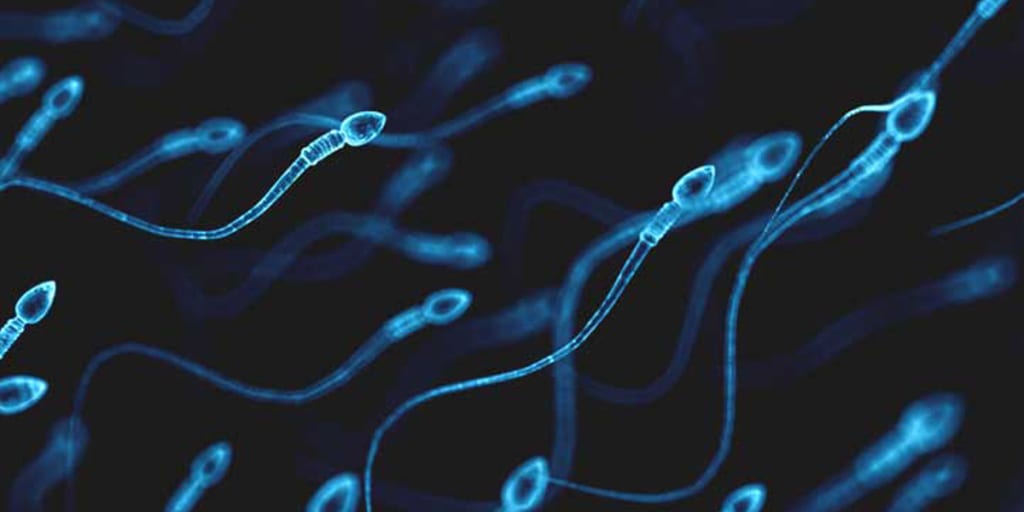The Lifespan of a Sperm
How are they created? And what happens to them?

It's fairly common knowledge that the testicles produce millions of sperm every day, but how much do you know beyond that? Sperm are not produced and ejaculated later that same day. There is a bit more to the process before those little guys are even able to swim, let alone be part of the ejaculation. Every sperm has a lifespan and a goal to complete. Millions of sperm may be produced, but few live to fulfill their genetic purpose. How do they grow? What happens to them if they don't come in contact with an egg?
The Sperm Lifespan
It was originally thought that it takes 60-75 days for sperm to fully mature. Research in the last ten years has found that the actual time may be as low as 42 days.
When a person with a penile reproductive system is born, they have a number of underdeveloped sperm cells. These cells are not sperm yet, but come to mature at puberty and begin to create reproductive cells. They basically make exact copies of themselves that will go on to become reproductive sperm cells. Typically, each underdeveloped cell will make four copies to mature. This process is called spermatogenesis.
As the reproductive sperm matures, it will have a head, a midpiece, and a tail. The head is where 23 chromosomes of genetic information are stored. These chromosomes combine with the egg chromosomes when a baby begins to grow. The midpiece contains a filamentous core. This core helps the sperm recharge and maintain energy while it makes its journey and tries to reach an egg to fertilize. Finally, the tail is what helps the sperm move through its environment. Once sperm mature, they make their way through the reproductive tract and are ejaculated out in the semen.
When Do Sperm Die?
If sperm do not come into contact with an egg, how long do they live? Well, the answer is pretty variable and dependent on the conditions. In a laboratory test where they were able to create highly favorable conditions for sperm, the sperm lived for a full seven days. Is this likely to happen within a vagina? Nope!
Research has shown that sperm can live for up to five days in the cervical fluid of a vagina. They could come into contact and fertilize an egg within that window, so it's possible for a child to be conceived up to a few days after the physical sexual act itself occurred. So what happens to all the sperm that doesn't come into contact with an egg? The vagina canal is usually where most of the sperm end up if they don't reach the egg. The vagina is good at keeping itself clean and healthy and produces acidic pH, vaginal flora, and mucosal secretions. All of these things break down the dead sperm and flush it out of the vagina.
If sperm end up being ejaculated outside of a body to a surface instead, all the sperm will die by the time the ejaculation has dried. Sperm may survive a bit longer in a warm, wet environment such as a bath, but they wouldn't live much beyond a few hours, and their ability to fertilize drops significantly after 60 minutes.
If sperm are frozen at extremely low temperatures, they can survive for years if the temperature remains stable. At such low temperatures, they go into a type of suspended animation state where all of their essential functions are completely stopped. This can be useful for anyone wishing to preserve their reproductive chances if they have to undergo something that could cause them infertility.
What Happens to Sperm that Is Never Ejaculated?
Depending on a person's sex life, it may come to be that the sperm reaches the end of their lifespan without being ejaculated. If this happens, the sperm are broken down by the body so that the nutrients can be reused to produce new sperm. They are broken down and reabsorbed by the body in a very similar fashion that blood cells are broken down. It's the body's way of recycling and ensuring that no nutrients are lost unnecessarily.
Reabsorbing sperm is not damaging and a totally natural process that bodies are designed to do. It doesn't hurt the penile reproductive system to reabsorb unused sperm. This is actually quite a common process. Even those with a very active sex life will still have a fraction of sperm that is never ejaculated. So there is no reason to worry that this could cause any sort of issue.
The Importance of Knowing Anatomy
Sperm life is another interesting aspect of the human body. Most of it takes place flying way under the radar, where no one will notice these details. So why is it important to know? Having a good understanding of human anatomy is a good foundation of knowledge to have. This information would be particularly important for anyone trying to get pregnant (or for those trying to actively avoid pregnancy). Sperm life is one important piece of fertility, and by extension, sex. All knowledge is worth having, and it can make for some interesting conversations that make you look super smart! Share this article and strike up a good conversation with someone in your life!
Enjoyed This Article?
Check out the other great articles, games, and more on my website
About the Creator
Teela Hudak
Teela is a Vancouver-based Sex Educator & Relationship Expert. Learn more at: https://exploresextalk.com/






Comments
There are no comments for this story
Be the first to respond and start the conversation.